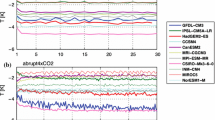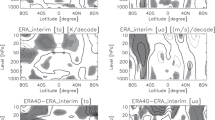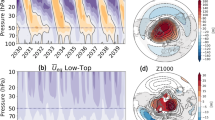Abstract
The role of stratospheric dynamics in past and projected future long-term changes of the Southern Hemisphere climate is examined with a special regard to the oceanic carbon uptake, by comparing results from two sets of simulations performed with the high-top version and the low-top version of the CMCC-Carbon Earth System Model. An improved description of the stratospheric dynamics results in weakened (~20 to 25 %) annual-mean Southern Ocean air-to-sea carbon fluxes in the 1990–2005 period, with implications for the global ocean carbon uptake. Simulated changes in the Southern Hemisphere climate are reproduced in both model simulations and are consistent with numerous previous studies. However, the low-top model is unable to fully capture the observed stratospheric cooling, because the component associated with the changes in stratospheric circulation is missing. Smaller trend of the stratospheric polar vortex found in the low-top model (in response to stratospheric ozone and greenhouse gas changes) is followed by a smaller trend of the poleward-shifted tropospheric jet in the troposphere. The latter implies smaller (~10 %) wind stress increase in the November to February season and a smaller projection on Sea Level Pressure changes. Our results point out the importance of including a proper representation of stratospheric dynamics, at least with a certain degree of detail, in order to obtain more reliable long-term climate simulations and projections in the Southern Hemisphere circulation patterns and air-sea fluxes.











Similar content being viewed by others
References
Bellucci A et al (2012) Decadal climate predictions with a coupled OAGCM initialized with oceanic reanalyses. Clim Dyn. doi: 10.1007/s00382-012-1468-z (in press)
Alessandri A (2006) Effects of land surface and vegetation processes on the climate simulated by an atmospheric general circulation model. PhD Thesis, Bologna University Alma Mater Studiorum
Alessandri A, Fogli PG, Vichi M, Zeng N (2012) Strengthening of the hydrological cycle in future scenarios: atmospheric energy and water balance perspective. Earth Syst Dyn Discuss 3:523–560. doi:10.5194/esdd-3-523-2012
Andrews DG, Holton JR, Leovy CB (1987) Middle atmospheric dynamics. Academic Press, San Diego
Boening CW, Dispert A, Visbeck M, Rintoul SR, Schwarzkopf FU (2008) The response of the Antarctic circumpolar current to recent climate change. Nat Geosci 1:864–869. doi:10.1038/ngeo362
Cagnazzo C, Manzini E (2009) Impact of the stratosphere on the winter tropospheric teleconnections between ENSO and the North Atlantic and European region. J Clim 22:1223–1238. doi:10.1175/2008JCLI2549.1
Cagnazzo C, Manzini E, Giorgetta MA, De PMP, Forster F, Morcrette JJ (2007) Impact of an improved shortwave radiation scheme in the MAECHAM5 general circulation model. Atmos Chem Phys 7:2503–2515. doi:10.5194/acp-7-2503-2007
Charlton-Perez AJ et al (2013) On the lack of stratospheric dynamical variability in low-top versions of the CMIP5 models. J Geophys Res Atmos 118. doi:10.1002/jgrd.50125
Cionni I et al (2011) Ozone database in support of CMIP5 simulations: results and 718 corresponding radiative forcing. Atmos Chem Phys Discuss 11:10875–10933
Fogli PG, Manzini E, Vichi M, Alessandri LPA, Gualdi S, Scoccimarro E, Masina S, Navarra A (2009) INGV-CMCC Carbon: a Carbon Cycle Earth System Model, Tech. Rep. RP0061,CMCC. http://www.cmcc.it/publications-meetings/publications/research-papers/rp0061-ingv-cmcccarbon-icc-a-carbon-cycle-earth-system-model
Fogt RL, Perlwitz J, Monaghan AJ, Bromwich DH, Jones JM, Marshall GJ (2009) Historical SAM variability. Part II: twentieth-century variability and trends from reconstructions, observations, and the IPCC AR4 models. J Clim 22:5346–5365
Follows MJ, Ito T, Dutkiewicz S (2006) On the solution of the carbonate chemistry system in ocean biogeochemistry models. Ocean Modelling 12(3–4):290–301
Fyfe JC, Saenko OA (2006) Simulated changes in the extratropical Southern Hemisphere winds and currents. Geophys Res Lett 33:L06701. doi:10.1029/2005GL025332
Gerber EP et al (2012) Assessing and understanding the impact of stratospheric dynamics and variability on the earth system. Bull Amer Meteor Soc 93:845–859.http://dx.doi.org/10.1175/BAMS-D-11-00145.1
Gillett NP, Thompson DWJ (2003) Simulation of recent Southern Hemisphere climate change. Science 302:273–275
Goosse H, Arzel O, Bitz CM, de Montety A, Vancoppenolle M (2009) Increased variability of the Arctic summer ice extent in a warmer climate. Geophys Res Lett 36:L23702. doi:10.1029/2009GL040546
Graversen RG, Christiansen B (2003) Downward propagation from the stratosphere to the troposphere: A comparison of the two hemispheres. J Geophys Res 108. doi:10.1029/2003JD004077
Gruber N, Gloor M, Mikaloff-Fletcher SE, Doney SC, Dutkiewicz S, Follows MJ, Gerber M, Jacobson AR, Joos F, Lindsay K, Menemenlis D, Mouchet A, Mueller SA, Sarmiento JL, Takahashi T (2009) Oceanic sources, sinks, and transport of atmospheric CO2. Global Biogeochem Cycles 23:GB1005. doi:10.1029/2008GB003349
Ito T, Woloszyn M, Mazloff M (2010) Anthropogenic carbon dioxide transport in the Southern Ocean driven by Ekman flow. Nature 463:80–83. doi:10.1038/nature08687
Iudicone D, Rodgers KB, Stendardo I, Aumont O, Madec G, Bopp L, Mangoni O, Ribera d’Alcala M (2011) Water masses as a unifying framework for understanding the Southern Ocean carbon cycle. Biogeosciences 8:1031–1052. doi:10.5194/bg-8-1031-2011
Johns TC, Royer J-F, Höschel I, Huebener H, Roeckner E, Manzini E, May W, Dufresne J-L, Otterå OH, van Vuuren DP, Salas y Melia D, Giorgetta M, Denvil S, Yang S, Fogli PG, Körper J, Tjiputra JF, Stehfest E, Hewitt CD (2011) Climate change under aggressive mitigation: the ENSEMBLES multi-model experiment. Clim Dyn 37:1975–2003. doi:10.1007/s00382-011-1005-5
Kang SM, Polvani LM, Fyfe JC, Sigmond M (2011) Impact of polar ozone depletion on subtropical precipitation. Science 332:951–954
Karpechko AY, Manzini E (2012) Stratospheric influence on tropospheric climate change in the Northern Hemisphere. J Geophys Res 117:D05133. doi:10.1029/2011JD017036
Kidston J, Gerber EP (2010) Intermodel variability of the poleward shift of the austral jet stream in the CMIP3 integrations linked to biases in 20th century climatology. Geophys Res Lett 37:9708. doi:10.1029/2010GL042873
Kushner PJ, Polvani LM (2004) Stratosphere–troposphere coupling in a relatively simple AGCM: the role of eddies. J Clim 17:629–639
Kushner PJ, Held IM, Delworth TL (2001) Southern Hemisphere atmospheric circulation response to global warming. J Clim 14:2238–2249
Le Quéré C et al (2007) Saturation of the Southern Ocean CO2 sink due to recent climate change. Science 316:1735–1738. doi:10.1126/science.1136188
Lenton A, Codron F, Bopp L, Metzl N, Cadule P, Tagliabue A, Le Sommer J (2009) Stratospheric ozone depletion reduces ocean carbon uptake and enhances ocean acidification. Geophys Res Lett 36:L12606. doi:10.1029/2009GL038227
Lovenduski NS, Ito T (2009) The future evolution of the Southern Ocean CO2 sink. J Mar Res 67:597–617. doi:10.1357/002224009791218832
Lovenduski NS, Gruber N, Doney SC (2008) Toward a mechanistic understanding of the decadal trends in the Southern Ocean carbon sink. Global Biogeochem Cycles 22:GB3016. doi:10.1029/2007GB003139
Madec G, Delecluse P, Imbard M, Levy C (1998) OPA8.1 ocean general circulation model reference manual, Notes du pole de modelisation, IPSL, France, http://www.nemoocean.eu/Media/Files/Doc_OPA8.1
Manzini E, Steil B, Brühl C, Giorgetta MA, Krüger K (2003) A new interactive chemistry-climate model: 2. Sensitivity of the middle atmosphere to ozone depletion and increase in greenhouse gases and implications for recent stratospheric cooling. J Geophys Res 108(D14):4429. doi:10.1029/2002JD002977
Manzini E, Giorgetta MA, Esch M, Kornblueh L, Roeckner E (2006) The influence of sea surface temperatures on the northern winter stratosphere: ensemble simulations with the MAECHAM5 model. J Clim 19:3863–3881. doi:10.1175/JCLI3826.1
Manzini E, Cagnazzo C, Fogli PG, Bellucci A, Müller WA (2012) Stratosphere-troposphere coupling at inter-decadal time scales: implications for the North Atlantic Ocean. Geophys Res Lett 39:L05801. doi:10.1029/2011GL050771
McLandress C, Jonsson AI, Plummer DA, Reader MC, Scinocca JF, Shepherd TG (2010) Separating the dynamical effects of climate change and ozone depletion. Part I: southern Hemisphere stratosphere. J Clim 23:5002–5020
Meredith MP, Naveira Garabato AC, Hogg AM, Farneti R (2012) Sensitivity of the overturning circulation in the Southern Ocean to decadal changes in wind forcing. J Clim 25:99–110. doi:10.1175/2011JCLI4204.1
Orr A, Bracegirdle TJ, Hosking SJ (2012) Possible dynamical mechanisms for Southern Hemisphere climate change dur to the ozone hole. J Atmos Sci 69:2917–2932. doi:10.1175/JAS-D-11-0210.1
Patara L, Vichi M, Masina S, Fogli PG, Manzini E (2012) Global response to solar radiation absorbed by phytoplankton in a coupled climate model. Clim Dyn 39(7):1951–1968. doi:10.1007/s00382-012-1300-9
Perlwitz J, Pawson S, Fogt RL, Nielsen JE, Neff WD (2008) Impact of stratospheric ozone recovery on Antarctic climate. Geophys Res Lett 35:L08714. doi:10.1029/2008GL033317
Polvani LM, Waugh DW, Correa GJP, Son S-W (2011a) Stratospheric ozone depletion: the main driver of twentieth-century atmospheric circulation changes in the Southern Hemisphere. J Clim 24:795–812
Polvani LM, Previdi M, Deser C (2011b) Large cancellation, due to ozone recovery, of future Southern Hemisphere atmospheric circulation trends. Geophys Res Lett 38:L04707. doi:10.1029/2011GL046712
Randel WJ, Wu F (1999) A stratospheric ozone trends data set for global modeling studies. Geophys Res Lett 26:3089–3092
Roeckner E, Brokopf R, Esch M, Giorgetta M, Hagemann S, Kornblueh L, Manzini E, Schlese U, Schulzweida U (2006) Sensitivity of simulated climate to horizontal and vertical resolution in the ECHAM5 atmosphere model. J Clim 19:3771–3791
Sabine CL, Feely RA, Gruber N, Key RM, Lee K, Bullister JL, Wanninkhof R, Wong CS, Wallace DWR, Tilbrook B, Millero FJ, Peng T-H, Kozyr A, Ono T, Rios AF (2004) The oceanic sink for anthropogenic CO2. Science 305(5682):367–371. doi:10.1126/science.1097403
Scaife AA, Knight JR, Vallis GK, Folland CK (2005) A stratospheric influence on the winter NAO and North Atlantic surface climate. Geophys Res Lett 32:L18715. doi:10.1029/2005GL023226
Scaife AA et al (2012) Climate change projections and stratosphere–troposphere interaction. Clim Dyn. doi:10.1007/s00382-011-1080-7
Scoccimarro E, Gualdi S, Bellucci A, Sanna A, Fogli PG, Manzini E, Vichi M, Oddo P, Navarra A (2011) Effects of tropical cyclones on ocean heat transport in a high resolution coupled general circulation model. J Clim 24:4368–4384. doi:10.1175/2011JCLI4104.1
Seferian R, Iudicone D, Bopp L, Roy T, Madec G (2012) Water mass analysis of effect of climate change on air–sea CO2 fluxes: the Southern Ocean. J Clim 24:3894–3908. doi:10.1175/JCLI-D-11-00291.1
Sigmond M, Fyfe JC (2010) Has the ozone hole contributed to increased Antarctic sea ice extent? Geophys Res Lett 37:L18502. doi:10.1029/2010GL044301
Solomon S (1999) Stratospheric ozone depletion: a review of concepts and history. Rev Geophys 37(3):275–316. doi:10.1029/1999RG900008
Son S-W et al (2008) The impact of stratospheric ozone recovery on the Southern Hemisphere westerly jet. Science 320:1486–1489. doi:10.1126/science.1155939
Son SW et al (2010) Impact of stratospheric ozone on the Southern Hemisphere circulation changes: a multimodel assessment. J Geophys Res 115:D00M07. doi:10.1029/2010JD014271
Song Y, Robinson WA (2004) Dynamical mechanisms for stratospheric influences on the troposphere. J Atmos Sci 61:1711–1725
SPARC CCMVal (2010), SPARC report on the evaluation of chemistry–climate models. V. Eyring, T. G. Shepherd, and D. W. Waugh, Eds., SPARC Rep. 5, WCRP-132, WMO/TD– 1526. Available online at http://www.atmosp.physics.utoronto.ca/SPARC/ccmval_final/index.php
Swart NC, Fyfe JC (2011) Ocean carbon uptake and storage influenced by wind bias in global climate models. Nat Clim Change 2:47–52
Thompson DWJ, Solomon S (2002) Interpretation of recent Southern Hemisphere climate change. Science 296:895–899
Thompson DWJ, Solomon S, Kushner PJ, England MH, Grise KM, Karoly DJ (2011) Signatures of the Antarctic ozone hole in Southern Hemisphere surface climate change. Nat Geosci 4:741–749
Toggweiler JR (2009) Shifting westerlies. Science 323(5920). doi:10.1126/science.1169823
Turner J et al (2009) Non-annular atmospheric circulation change induced by stratospheric ozone depletion and its role in the recent increase of Antarctic sea ice extent. Geophys Res Lett 36:L08502. doi:10.1029/2009GL037524
Uppala S, Kallberg P, Simmons A, Andrae U, da Costa Bechtold V, Fiorino M, Gibson J, Haseler J, Hernandez A, Kelly G, Li X, Onogi K, Saarinen S, Sokka N, Allan R, Andersson E, Arpe K, Balmaseda M, Beljaars A, van de Berg L, Bidlot J, Bormann N, Caires S, Chevallier F, Dethof A, Dragosavac M, Fisher M, Fuentes M, Hagemann S, Holm E, Hoskins B, Isaksen L, Janssen P, Jenne R, McNally A, Mahfouf J-F, Morcrette J–J, Rayner N, Saunders R, Simon P, Sterl A, Trenberth K, Untch A, Vasiljevic D, Viterbo P, Woollen J (2005) The ERA-40 re-analysis. Quart J Roy Meteor Soc 131:2961–3012. doi:10.1256/qj.04.17
Vichi M, Pinardi N, Masina S (2007) A generalized model of pelagic biogeochemistry for the global ocean ecosystem. Part I: theory. J Mar Sys 64:89–109
Vichi M, Manzini E, Fogli PG, Alessandri A, Patara L, Scoccimarro E, Masina S, Navarra A (2011) Global and regional ocean carbon uptake and climate change: sensitivity to a substantial mitigation scenario. Clim Dyn 37:1929–1947. doi:10.1007/s00382-011-1079-0
Wanninkhof R (1992) Relationship between windspeed and gas exchange over the ocean. J Geophys Res 97:7373–7382
Zickfeld K, Fyfe JC, Saenko OA, Eby M, Weaver AJ (2007) Response of the global carbon cycle to human-induced changes in Southern Hemisphere winds. Geophys Res Lett 34:L12712. doi:10.1029/2006GL028797
Acknowledgments
Chiara Cagnazzo is grateful to Bill Randel, Rolando Garcia, Dan Marsh and Natalia Calvo for useful discussions during the preparation of this manuscript. This work was partially funded by the European Commission’s 7th Framework Programme, under GA226520, COMBINE project. We acknowledge the support of Italian Ministry of Education, University and Research and Ministry for Environment, Land and Sea through the project GEMINA.
Author information
Authors and Affiliations
Corresponding author
Appendix
Appendix
Analysis of temperature and zonal wind trends from two other CMCC model versions: the CMCC-CMS model (Manzini et al. 2012) and the CMCC-CM model (Scoccimarro et al. 2011; Bellucci et al. 2012). The first one is a high-top model with high vertical resolution, top at 0.01 hPa, 95 vertical layers and T63 horizontal resolution; the second one is a low-top model with top at 10 hPa, 31 vertical layers and T159 horizontal resolution. These two models do not include the land-surface and ocean biogeochemistry components (See Figs. 11, 12).
Linear trends of the horizontal and vertical components of the EP-flux divergence in the HT and LT model simulations (See Figs. 13, 14).
As Fig. 4—bottom-left panel panels but for: (left) the CMCC-CMS high-top model; (right) the CMCC-CM low top model
As Fig. 5 but black contours are trends in the horizontal component of the EP flux divergence (m/s/day/decade), colors are positive (red) and negative (blue) zonal mean zonal wind trends (m/s/decade)
As Fig. 5 but black contours are trends in the vertical component of the EP flux divergence (m/s/day/decade), colors are positive (red) and negative (blue) zonal mean zonal wind trends (m/s/decade)
Rights and permissions
About this article
Cite this article
Cagnazzo, C., Manzini, E., Fogli, P.G. et al. Role of stratospheric dynamics in the ozone–carbon connection in the Southern Hemisphere. Clim Dyn 41, 3039–3054 (2013). https://doi.org/10.1007/s00382-013-1745-5
Received:
Accepted:
Published:
Issue Date:
DOI: https://doi.org/10.1007/s00382-013-1745-5







